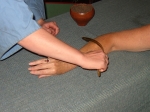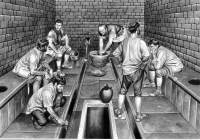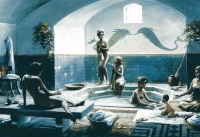



Hygiene and Health
Water, hygiene and health constitute an interesting triangle and have strong relations to each other. The Roman bath culture is often seen as a proof that the Romans were tidy people. But hygiene as such was not an issue although the Romans did believe that illness had a natural cause and that bad health could be caused by bad water and sewage. So some measures were taken to improve the public health system.Personal health
The majority of the Roman people lived in small dwellings, single rooms or apartment houses without facilities. They got their water from public wells or aqueduct fed fountains. The rivers were often polluted. For personal hygiene they went to a public or commercial bath establishment. Living quarters had no drainage system nor toilet facilities and in the private rooms chamber pots were often used which sometimes were emptied out their windows. Since there was no official street cleaning service, the congested neighborhoods were malodorous and plagued with files and dogs, which spread diseases.Private homes might have latrines but these were often situated annex to the kitchen. Otherwise chamber pots were used which content would be dumped periodically into cesspits. When the domus or villa had their own connection to the public water supply, the toilets were flushed by surplus water from the kitchen, the garden or a private baths.
It was believed that each head of the household knew enough about herbal cures and medicines to treat illness. As the Roman empire expanded, many Greek doctors came to Italy and Rome; many of them were slaves owned by wealthy Roman citizens. It is said that the Romans were great believers in a healthy mind equaling a healthy body, but doctors regularly recommended their patients to visit public baths for their therapeutic value which could cause harm to other visitors.
Most problematic diseases were malaria, tuberculosis, and typhoid. Elderly and children aged between 1 and 5 years old were particularly vulnerable. The Romans became practices at draining marshes to rid areas of malaria-carrying mosquitoes. Julius Caesar ordered the drainage of the Codetan swamps, reducing malaria hazards.
Special attention was paid to soldiers: access to clear water - permanent military forts were often equipped with an aqueduct -, latrines and whenever possible to toilets with flushing water. Some military forts had a sewer system and were embellished with a bath building. Even some military hospitals are known.
Baths and public health
One of the major reasons for the construction of aqueducts was the water supply of bath buildings. Public baths played an important role in Roman life from the third century B.C. to the end of the Roman Empire. Initially the baths were viewed as a luxury, but by the Late Republic going to the public baths regularly was regarded as a necessity. Public baths were not just seen as a place to get clean, but they served as a place to meet and socialize with friends, a gathering place to tap into local and city gossip, a place to get an athletic workout, and a place to get warm in the winter (baths were some of the only buildings to have furnace heating).There must have been hundreds of small privately owned bath establishments either annex to wealthy villas in the countryside, or in the districts of Roman towns. The Romans did not have disinfectants and it is likely that the bathing pools were only periodically emptied and cleaned. In addition, the baths often had built-in toilets which recycled bath water to carry away the waste.
Apart from public and private baths, there were thermal baths: the spas, based on ancient springs of hot and/or rich on medicinal water, and often already in use in pre-Roman times. These amenities have given their name to many Roman towns like Aquae Sulis (Bath, UK), Aquae Viva (Varazdin, Croatia), Aquae Granni (Aachen, Germany), Aquae Cutiliae (Cutilia, Italy), Aquae Neris (Neris les Bains !), and Aquae Sextiae (Aix-en-Provence, France). Many of these springs are still in use!
It was customary for a toilets either to be incorporated into a public bath building or to be adjacent to one. On average, public toilets (forica) could accommodate between 10 and 20 people at a time, affording no privacy to its patrons. Water running through a channel beneath the seats removed the waste, and toilet sponges were available for the patrons' use; these reusable sponges were a breeding-ground for bacteria.
Rome had an extensive network of drains (mainly for rain water) and sewers (mainly for excrements). Open gutters and sewers ran down the middle and sides of some of Rome's streets. Excess water from the aqueducts and runoff water from local streams were used to flush the sewers and drains of Rome.
The first major public sewer, the Cloaca Maxima ("The Great Drain"), was originally built by Romans to drain the marshy areas which eventually became the Roman Forum. The Cloaca Maxima - a huge covered drain by the time of the Late Republic - functioned both as Rome's main storm drain and means of sewage disposal. It is by now operational and still empties into the Tiber river.